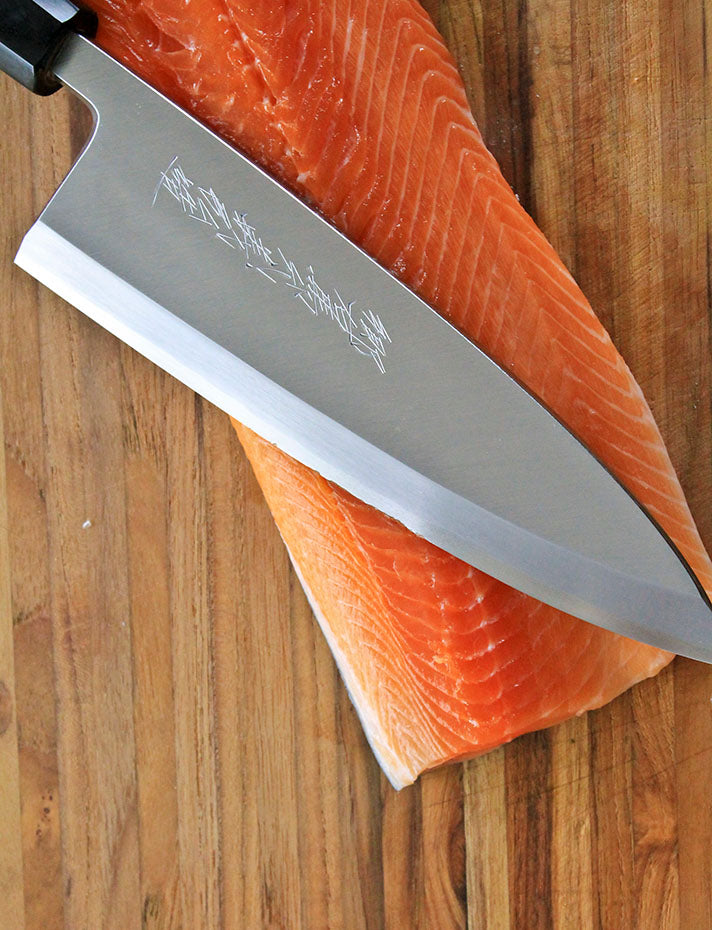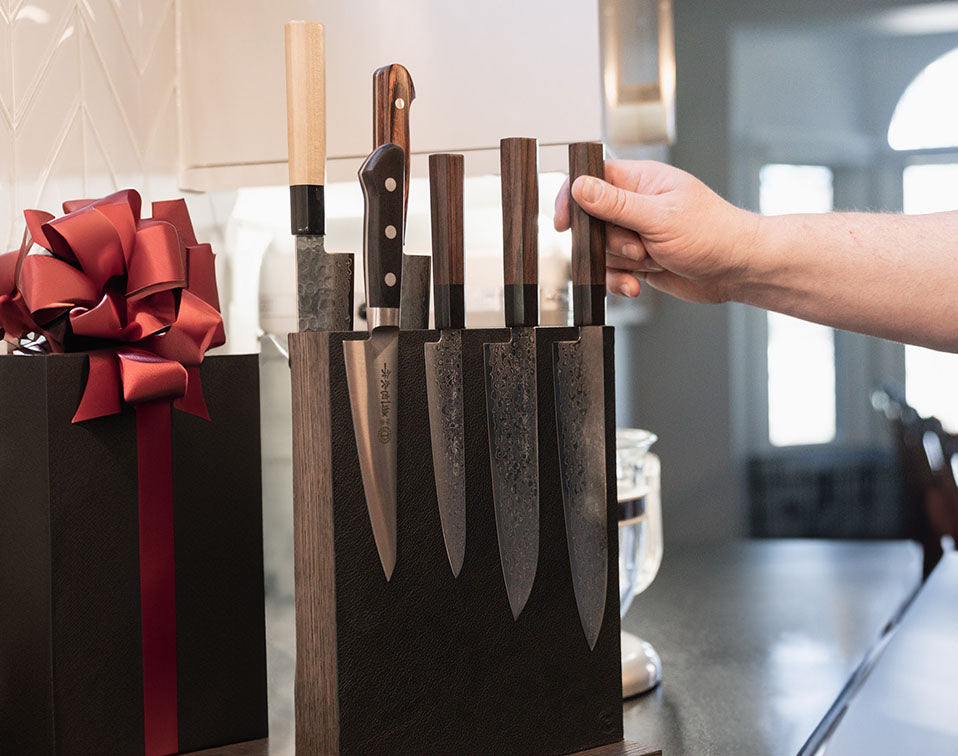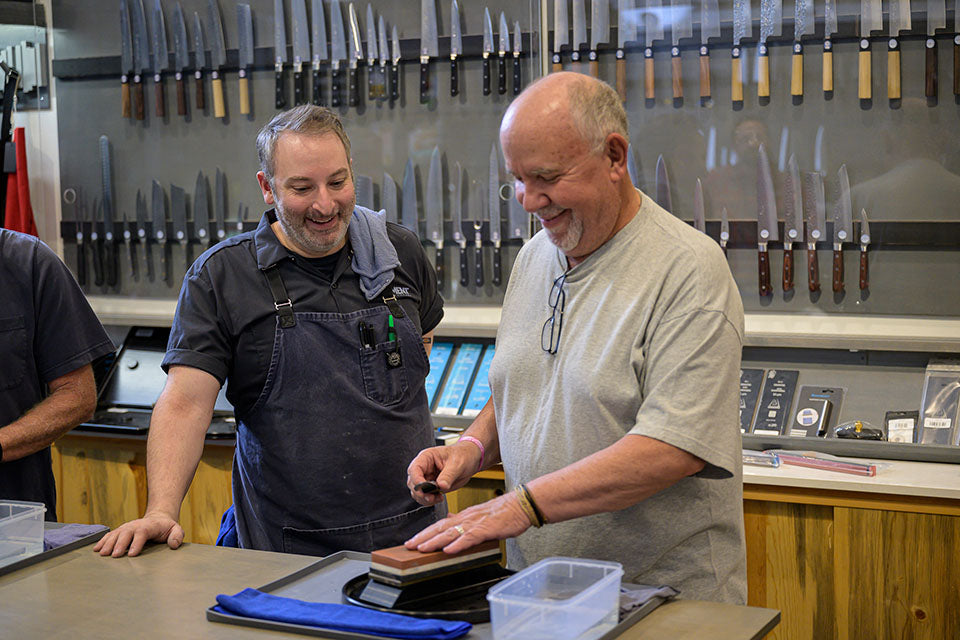Bevels & Grinds
Bevels, Edges, & Geometry Overview
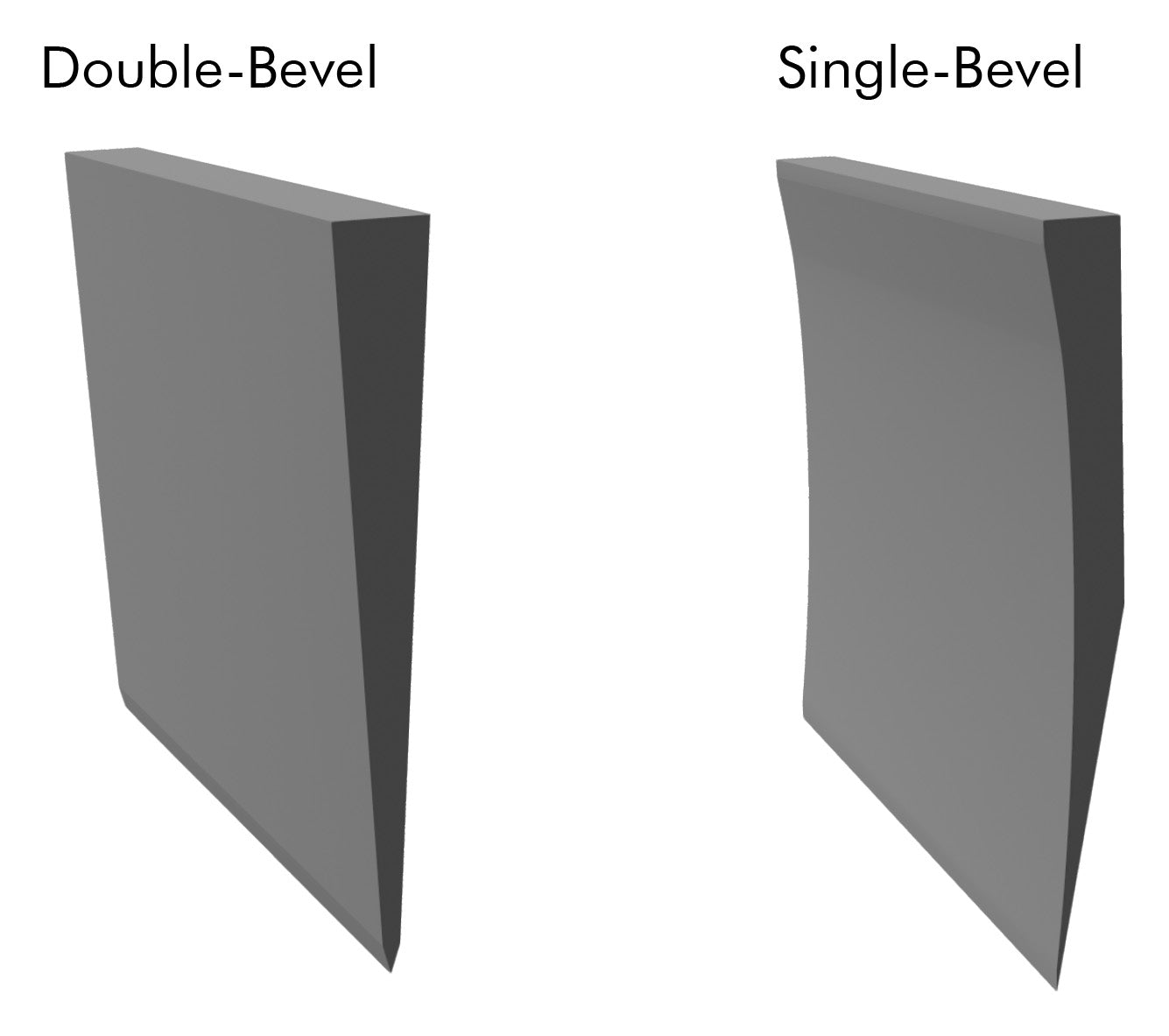
Bevels, Grinds, & Finishes
What Is A Bevel?
When we take a close look at a knife’s cross-section, we can see tapers & angles. The bevels (angles) that come together at the cutting edge are the primary bevel and this is responsible for the main cutting action of a knife. These bevels are ground away from the face of the blade and are what is addressed when a knife is then resharpened. The taper on the face of the blade (getting thinner from the spine toward the cutting edge) is the secondary bevel. This secondary bevel can also affect the overall cutting action of a knife. There are different styles, types, and nuances for both the primary and secondary bevels. This holds true for single-bevel and double-bevel knives. Single-bevel knives have one bevel (edge) on the face of the knife and the back side is slightly concave. These can be left-or right-hand specific. Double-bevel knives have a bevel (edge) on each face of the knife, and are mostly ambidextrous, but there are offset designs coming out of Japan. These Japanese offset double-bevel designs are also left-or right-hand specific. German knives are double-bevel. Japanese knives are either double-bevel or single-bevel. Historically in Japan, single-bevel knives are mostly used in professional kitchens.
Check out our History Of Knife Making blog posts for more info!

Double-Bevel Symmetrical & Offset
Here, we take a closer look at how both symmetrical and offset cutting edges can be established on blades featuring matching secondary grinds. Symmetrical double-bevel knives offer a 50:50 V-shaped edge. An asymmetrical double-bevel edge will be sharpened more on one side. Sometimes, Japanese manufacturers provide a head start, enabling users to favor the grind on one side, although a symmetrical cutting edge can still be achieved due to the blade’s symmetrical secondary bevel.
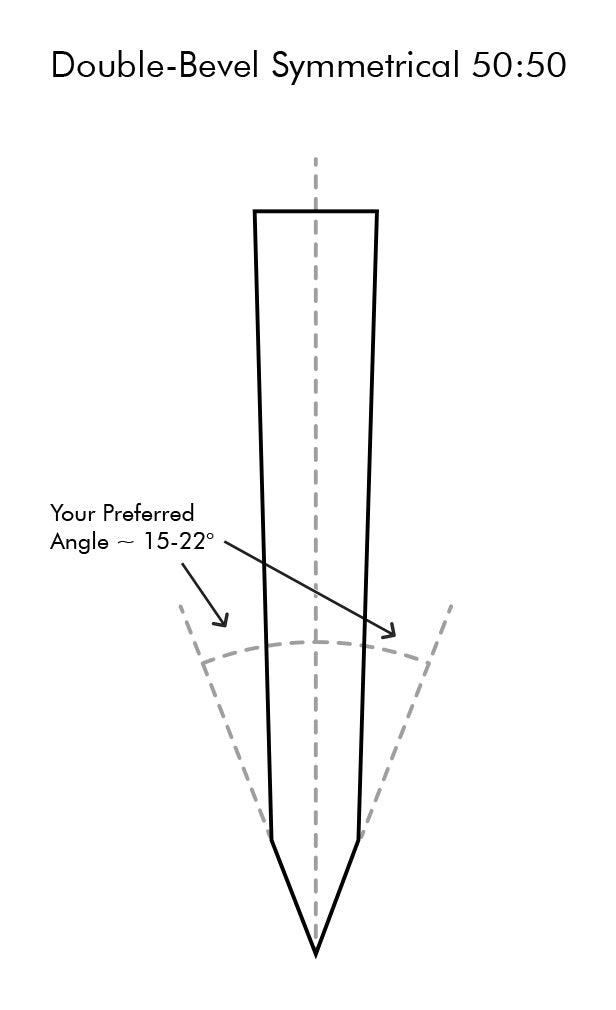
Bevels & Grinds
Symmetrical Double-Bevel
Symmetrical double-bevel knives have an edge that is ground on both sides of the blade forming a 50:50 symmetrical V-shape. Commonly, German cutlery have thicker blades and are manufactured with edges which are ground at 18° to 22°, although up to 30 degrees is established on Meat Cleavers. A broader edge is stronger, which is important when hammering strikes are used toward bone and the cutting board. Generally, Japanese knives are thin in comparison to German and come with edges ground at 15° to 18°.

Bevels & Grinds
Asymmetrical Double-Bevel (Offset)
Asymmetrical double-bevel edges are most common to Japanese cutlery and are offset accordingly to right- or left-handedness. Often, it is up to the user to establish an offset edge after they purchase the knife. Some Japanese manufacturers understand that chefs have their own edge and sharpening preferences. They purposefully give the purchaser a head start by favoring the grind (cutting edge), usually on the right side of the knife. Additionally, there is a Japanese blade geometry called Ryouba, 両刃. This means that the taper is only on the face of the knife as opposed to both sides. And, the back side is flat. There are three variations of the Ryouba; Full Flat-Ground, Half-Flat Ground, and Curved. Offset bevels are accomplished through percentages, not degrees. Users determine their offset preferences. Common ratios are 70:30, 80:20, or 90:10. Remember, offset edges require matching degrees from side to side, typically 15° to 18°, but are ground more on one side than the other.
Ryoba - Asymmetrical Double-Bevel (Offset)
Ryoba, 両刃, is a Japanese asymmetrical double-bevel blade geometry design. Meaning that the taper is only on one face (primary side) of the knife (as opposed to both sides) with the back side being flat. There are three variations of the Ryoba; Curved, Full Flat, & Half-Flat. Since the secondary bevels are not symmetrical, the primary bevel (cutting edge) must be offset. Once again, the user determines the offset preferences. Common ratios are 70:30, 80:20, or 90:10. Don’t forget, offset edges require matching degrees from side to side, typically 15° to 18°, but are ground more on one side than the other.
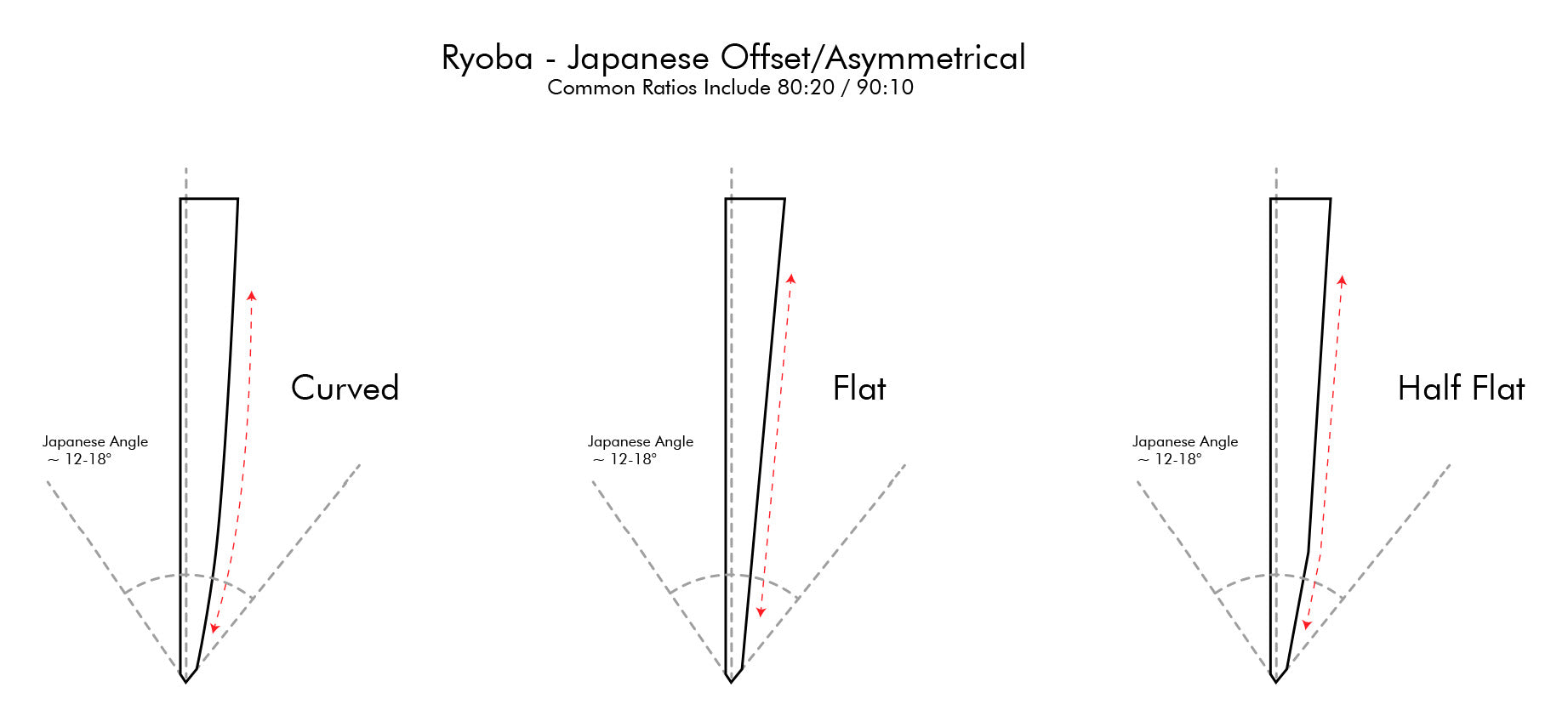
Single-Bevel
Single-Bevel knives originated in Japan, and are produced in a wide range of shapes and sizes Designed to perform specific tasks such as butchering fish, cutting vegetables, noodles, eel, etc. These Japanese knives are commonplace for professionals in Japanese kitchens, especially Sushi restaurants. This one-sided style of blade has the edge angle on the front with a slight convex shape on the back of the knife. This geometry allows for a much steeper taper that produces a very fine edge, usually 10° to 18°. These precise blades cut delicate food products with ease. A single-bevel knife tends to pull in the opposite direction of the holding hand (it takes practice). Also, single-bevel knives are specific to right- or left-handedness. For Japanese Single-Bevel knives, the degrees are narrower or wider depending on the thickness of the spine. Thicker knives, like a Deba, make for a wider, stronger angle, about an 18° bevel. This thicker knife is used for heavier duty tasks such as fish butchery. A thinner Yanagi, used for precise slicing, will have a narrower, more fragile bevel, approximately 11°. Aside from nuanced edge angles, the overall geometry is always the same, whether left- or right-handed. Within this single-bevel edge geometry, there are three different sharpening techniques, Koba, Hiratogi, & Hamaguriba. Each having its unique benefits and are up to the user of the knife to apply.

Bevels & Grinds
Koba
Koba, 小刃, is a style that most manufacturers apply to their single-bevel knives. This essentially puts a micro-bevel at the cutting edge. It’s up to the user of the knife to continue following this technique when resharpening or choose to change to another style. Koba offers a good balance between sharpness and strength.

Bevels & Grinds
Hiratogi
Hiratogi, 平研ぎ, offers the finest edge. It is very sharp, but more fragile. Commonly applied to slicing knives such as Yanagis, Takohikis, & Kiritsukes. Hiratogi is typically applied by the user of the knife once purchased, but sometimes can be applied by the retail shop that sells it (more common in Japan.) This essentially puts a final edge on the knife, referred to as “Honbadzuke”, which when translated means ‘sharpening to a sharper state’.

Bevels & Grinds
Hamaguriba
Hamaguriba, 蛤, makes for a very strong edge and helps to prevent chipping. It is named after a clam, referencing the clam shell’s rounded shape. This curvature is stronger, which helps strengthen the single-bevel’s inherent fragility. The trade-off is that the edge is less acute, rendering it less sharp. Typically applied to fish butchery knives like the Deba.
Learn Center
- Choosing a selection results in a full page refresh.
!

